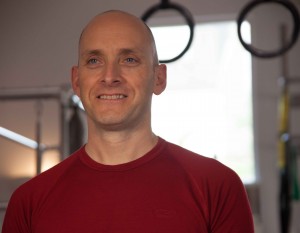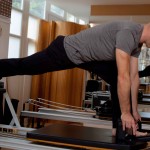December 20, 2017
My Pilates is Better Than Your Pilates
by Mike Perry
It’s clear that within the Pilates teaching industry, the issue of authenticity remains at the heart of many discussions. I do my best not to interact with people I don’t know on social media these days (apologies to anyone whom I may have offended in the past, while having never met) and steer clear of forums. Nonetheless, I might see things over my wife’s shoulder, or read blog posts, like this one, or Sabrina Svard’s recent Pilates Intel article.
My first, knee-jerk reaction was “Who cares?” I appreciate that there are some teachers who learned directly from members of the Pilates family, or from “first generation” teachers, who feel very strongly about preserving, like an artifact, exactly what was passed on to them (and I respect that desire).
At the same time, I’m sure there are other teachers whose zeal is like that of the reformed smoker – they now know that what went before was wrong, and they’re now on the true path. Anyone not on that path needs to know how wrong and foolish they are. I get this, too. When I first converted to a primal/paleo way of eating, the results were so profound that I was certain I had found THE way. I needed to bolster my (apparently fragile) belief by evangelizing and denouncing.
Rebekah Le Magny implies (see the link above) that we have a responsibility, as teachers, to make sure that the public understands what Pilates is, but I think there are a couple of problems with this. Firstly, Pilates (as an exercise methodology) is someone else’s name for Joseph’s exercises. As soon as that name was adopted, variations became inevitable. Romana and Eve were both there, I don’t think that’s in doubt, but apparently heard/saw/learned different ideas from Joseph. And they were only two of the many who went on to teach what they had learned (under the name of ‘Pilates’, by and large). I believe there is a trademark on Contrology that is enforceable, but even if there wasn’t (and that’s as the name we were all using), I’m sure that the debates would still be raging over authenticity.
If I make cheese, and then down the road from me someone starts manipulating soy into something of a similar consistency and calls it cheese, I might be angry, but it’s not my responsibility to try to educate the public about what cheese really is. I just have to make the best cheese that I can and balance my beliefs about how cheese should be with the demands/desires of my customers. (You may question the comparison between cheese and Pilates, but give it a few moments ((to ferment, if you will)) and I think you may find it sort of works.)
The authenticity arguments are invariably centered around exercises or apparatus and, I believe, this in itself misrepresents Joseph’s work – ‘Your Health’ is surely as much his work as ‘Return to Life’ was. In addition to that, the archival footage that exists of Joseph wrestling, or demonstrating how to wash properly, are also part of his work. And then there’s the bed, too.
To be an authentic Pilates teacher, how much of this work is it okay to ignore, or leave on the shelf? Ron Fletcher described Joseph supervising his post-class shower, to ensure that Ron wasn’t shirking in the scrubbing department. Or maybe in the sinus sluicing department – who knows anymore?
Wasn’t Joseph promoting health? Of which exercise is but one component? This is the cornerstone of how I teach and what we aim to promote at the studio that my wife and I own. We teach exercises, the majority of which look like what Joseph taught (as best as we understand that) or are components of what he taught. The outcome is never intended to be proficiency in executing these exercises, but health. This may well be as much to do with someone’s belief in what they are capable of, or understanding of their own mechanics, as it is to do with their strength and mobility. If you spent time at our studio, you’d very likely hear me talking about nutrition, increased tolerance to ranges of temperature, spending time barefoot, and spending time outdoors in nature. All of this seems entirely in keeping with what Joseph taught and wrote about.
When I write “My Pilates is better than yours”, my tongue is firmly in my cheek but the kernel of truth is that what I’m teaching is the best for me. It is the best that I can offer, based on my belief in what matters, and the education that I’m continually undergoing. I believe that the debate over classical vs. contemporary, creativity within Pilates, etc. can be resolved simply by all of us holding true to what we know now to be right while remaining open to other possibilities.
I teach the way that I do because I’m being as true to my beliefs and understanding as I can be. I choose apparatus and props based on a specific desired outcome, not for the sake of variety. If I ‘invent’ an exercise, or use a drill that I learned from a source outside the Pilates world, it’s to help achieve something specific –very often to facilitate Pilates repertoire.
I think that the great majority of the public, if they’re interested, can tell the difference between a business or individual driven by integrity and one driven by profit. We’re powerless to change those people or corporations, and there’s a saying about those things that one is powerless to change, and serenity ….
If the work that any of us do can enhance the wider reputation of Pilates teachers, that’s terrific. At the same time, the ‘right’ or ‘wrong’ way that I teach is not a reflection on another teacher, and vice versa. Back to that quote about change and serenity – I’m sure you know it – we don’t use our time or energy well in feeling aggrieved about another’s teaching (if only I’d recognized this a decade ago, I could have saved myself a lot of anguish – indignation is very rarely ‘righteous’, I suspect). We will achieve the best outcome for our ‘industry’, and each other, by being true to ourselves.

Mike Perry – Mike’s introduction to Pilates came as a result of a lower back injury, partly caused by a passion for running but without proper muscular balance or physical awareness. Needing to cut back on running, he turned to cycling and triathlon instead but still suffered recurring bouts of severe back pain. On the recommendation of an osteopath he began Pilates studio classes and within a few sessions had decided to apply to train to be a Pilates teacher.
Given that, at the time, dance was the usual background for teachers, Mike felt very fortunate that a carpenter and cabinet maker could train to teach Pilates. He qualified as a Pilates matwork teacher in 2003 and completed his training in 2004.
More recently, Mike has been researching an evolutionary biology perspective on human health and movement, as championed by the likes of Mark Sisson, Katy Bowman and many others. This means a keen interest in nutrition, strength & conditioning and (much like Joseph Pilates) how our whole lifestyle influences our health. This is in keeping with the Pilates in Motion Studio philosophy that Pilates is a beginning, rather than an end in itself, and that, along with the many other benefits of Pilates, increased strength is an outcome we hope all of our clients will seek.
He is also a CrossFit Level 1 Trainer, and CrossFit Mobility Trainer.
Mike makes occasional blog posts, covering Pilates, fitness and nutrition, that can be seen at www.paleolates.com.

